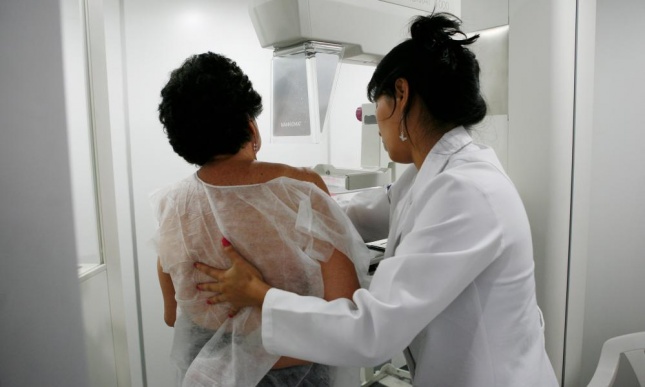
A woman undergoes a mammogram in Peru. Photograph: Enrique Castro-Mendivil/Reuters
Sarah Boseley Health editor
Women who undergo breast cancer screening cut their risk of dying from the disease by 40%, according to a global panel of experts attempting to end a long-running controversy about mammograms.
IARC, the International Agency for Cancer Research, an arm of the World Health Organisation, has weighed in with strong support for mammography screening, which has divided scientific opinion in recent years. Some scientists argue that few lives are saved and that screening does harm by identifying some small slow-growing cancers which are then treated with surgery, radiotherapy and drugs, but which would never have disturbed the woman in her lifetime.
IARC’s expert panel includes Stephen Duffy, the professor of cancer screening at Queen Mary University in London, and Julietta Patnick, who heads the NHS screening programme. Their viewpoint article is published in the prestigious New England Journal of Medicine.
Duffy said he hoped the analysis would set women’s minds at rest. “This important analysis will hopefully reassure women around the world that breast screening with mammography saves lives. The evidence proves breast screening is a vital tool in increasing early diagnosis of breast cancer and therefore reducing the number of deaths,” he said.
“In the UK, we are extremely fortunate to have the NHS breast screening programme where all women aged 50 to 70 years are invited to attend. Women invited to this service can be reassured the programme is endorsed by internationally respected organisations and experts.”
The debate is unlikely to be over, however. Even some of those who agree that screening does save lives say that IARC is probably overstating its case.
Prof Valerie Beral, director of the Cancer Epidemiology Unit at the University of Oxford, agreed with IARC that there was clear evidence for a 20% drop in mortality among all women invited for screening – of whom about a quarter will not go – but said there was no conclusive data on deaths prevented by screening among those women who do attend, because the studies were not done on that basis.
“Breast cancer mortality has halved in the last 20 years,” she said. “That is due to lots of things including much better treatment with hormonal therapy and chemotherapy. Screening is in there, but if you want to carve up what is due to treatment and screening, they are all playing some sort of role. But it is ridiculous to say screening is 40% because that is leaving nothing for hormonal therapies and so on.”
The controversy over breast cancer screening became so fierce that the then cancer tsar, ProfMike Richards, convened an expert panel to look at the risks and benefits. It concluded, in 2012, that there was a drop in deaths from screening programmes of about 20%.
It said about 1,300 lives were saved in the UK every year, but found the harms to be greater than had previously been thought. About 4,000 women undergo unnecessary treatment, including surgery, radiotherapy and chemotherapy, for a cancer they would not otherwise have known about and which would have done them no harm in their lifetime.
Some breast cancers are so tiny and slow growing that they would never be a threat to a woman’s health, the review said. The information leaflet for women invited to be screened was redesigned as a result, to give a clearer picture of the risks and benefits.
ProfDavid Cameron, clinical director of the Edinburgh Cancer Research Centre, who was on the review chaired by Sir Michael Marmot, said the IARC review broadly agreed with theirs, although it was hard to say how accurate the 40% figure was.
“They come up with an estimate, based on observational rather than randomised studies, that for those women that actually attend for screening, the breast cancer mortality may be as high as 40% … it is hard without seeing their assumptions and working to know how they got to the 40% figure.”
Sarah Williams, Cancer Research UK’s health information manager, said: “There isn’t one definitive answer to the question of how the benefits and harms of breast screening stack up – individual women will have different views on the factors that matter most to them, and also there are a number of different ways to bring together and interpret the evidence.”
“This latest review from IARC broadly agrees with the overall conclusions of the 2012 Independent Review of Breast Screening in the UK, commissioned by Cancer Research UK and the Department of Health, that breast screening reduces deaths from the disease but that on the other hand some women are overdiagnosed … as well as other harms.”
The IARC paper says there is not enough evidence to show whether screening is helpful for younger women, aged 40 to 49. It points to several studies suggesting screening saves lives among an older age group, aged 70 to 74, but others say it is possible this is an effect of the screening they had before the age of 70.
The paper concludes that there is only good evidence for mammography, which is the use of X-rays, to detect cancers. Duffy, however, hopes that other methods will show benefits in due course.
“Despite evidence that mammography screening is effective, we still need to carry out further research on alternative screening methods, such as the promising ‘digital breast tomosynthesis’; a newly developed form of 3D imaging which could potentially improve the accuracy of mammography in coping with more dense breast tissue,” he said.
“It is also vital we continue researching the most effective ways of screening women at high risk of breast cancer due to family history or genetic status. We need further evidence to fine-tune services offered to high-risk women in terms of different screening methods, from an earlier age and possibly at shorter intervals.”
The IARC panel looked at evidence from 11 randomised controlled trials and 40 observational studies to come to their conclusions.
